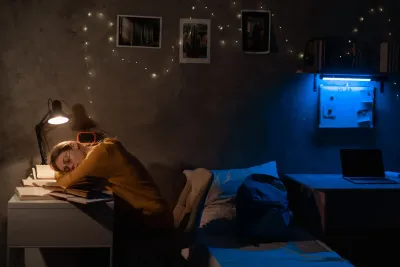
Key Takeaways
- Sleep Stage: Light sleep is a transitional phase that makes up about 40–50% of total sleep time.
- Brain Activity: Features slower waves and brief bursts called sleep spindles, aiding memory.
- Body Functions: Supports energy recovery, immune health, and prep for deeper sleep.
- Aging Effects: More light sleep and less deep sleep occur with age due to hormonal changes.
- Sleep Tracking: Good habits and trackers can optimize light sleep and overall rest quality.
Do you ever wake up feeling refreshed even if your dreams seemed vivid and your sleep wasn't rock-solid? That's the magic of sleep stages!
We'll explore what happens in your body and brain during the light sleep stage and why it's more important than it sounds. You'll learn to recognize the signs of light sleep and appreciate its role in memory, learning, and overall well-being.
What is Light Sleep?
Light sleep, also known as stage 2 sleep, is an early phase of the sleep cycle that acts as a transition from wakefulness to deeper sleep stages. This stage of sleep is characterized by slower brain waves and occasional bursts of rapid activity called sleep spindles. [1]
It is more easily awakened than deep sleep or REM sleep.
Light sleep is important for mental and physical relaxation, promoting healthy brain function, and preparing the body for deeper stages of sleep. Unlike the deep sleep stage, which is crucial for physical recovery and growth hormone secretion, and the REM sleep stage, which is essential for memory consolidation and mood regulation, light sleep plays a different but equally important role in the overall quality of sleep.
Understanding the role of light sleep can help you appreciate its importance in the sleep cycle and its contribution to overall health.
Take Charge of Your Sleep Temperature
Say goodbye to restless nights. With the Chilipad, you control your ideal sleep climate—cooler, warmer, or anywhere in between—for comfort that lasts throughout the night.
Apple Watch and Core Sleep
As we discuss the meaning and importance of light sleep, it's important to note that Apple refers to this stage of sleep as "core sleep." According to Apple, core sleep is a crucial part of the sleep cycle, encompassing the lighter stages of non-REM sleep.
To learn more, check out the article on Lifehacker, where they discuss why Apple calls light sleep "core sleep." Understanding how different sleep trackers label and interpret sleep stages can help you better measure and improve your sleep quality.
Note: By labeling it as core sleep, Apple emphasizes its fundamental role in maintaining overall health and well-being.

The Function of Light Sleep
When tracking their sleep, people often learn more about deep sleep and REM sleep stages. Light sleep, frequently underrated in discussions about restorative sleep, is also important to understand as it plays a crucial role in overall sleep quality.
While seemingly uneventful, light sleep orchestrates a fascinating dance of physiological processes. Brain waves slow down yet fire with bursts of activity, consolidating memories and boosting cognitive function. [2] Experts believe that these bursts are your brain organizing memories and information from the time you spend awake.
It also acts as a guardian, filtering out external disturbances to prepare the body for deeper, restorative sleep stages that promote physical healing and overall health. By understanding the functions of light sleep, we gain a deeper appreciation for this often-overlooked yet critical stage.
Did You Know: Stage 2 NREM sleep constitutes about 45% of your total sleep time, the longest duration of any stage. [3]
Is Light Sleep Good?
Remember that all sleep stages, including light sleep, deep sleep, and REM sleep, are important for a healthy sleep pattern. While light sleep helps the body relax and recharge, having enough deep and REM sleep is also necessary.
Prolonged or disrupted light sleep may affect sleep quality and lead to common sleep disorders, including sleep apnea, night terrors, insomnia, and others such as daytime sleepiness or fatigue.
How Much Light Sleep Do I Need?
Ever feel like you need the perfect amount of sleep to wake up feeling refreshed? Well, there's a science to it, and understanding how much light sleep you get is a significant part of the puzzle. It can make a world of difference in how well you rest and feel overall.
Typical Duration of Light Sleep
On average, you’ll go through 3-5 sleep cycles each night, with 40-50% of that time consisting of light sleep. This means spending around 3-4 hours in light sleep each night for adults. The amount can vary depending on individual sleep patterns and needs.
Note: How much light sleep you need varies per individual.
As we get older, the amount of light sleep increases while deep sleep decreases, with a reduction of about 10-12 minutes per decade. The change occurs because the body produces less growth hormone and melatonin. [4]
Learn More: Ways to Improve Your Deep Sleep
How Light Sleep Shifts with Age
Sleep patterns change over time. Babies and kids get more deep and REM sleep to fuel growth and development, while older adults spend more time in lighter, often more fragmented sleep. As we age, light sleep takes up a bigger share of the night.
The Sleep Cycles, Broken Down
Your night isn’t one long stretch of the same sleep—it’s a cycle with different stages, each pulling its own weight:
- Light Sleep (NREM 1 & 2): The gateway stage that helps you drift off and supports memory and learning.
- Deep Sleep (NREM 3 & 4): The body’s repair shop—key for growth, recovery, and physical restoration.
- REM Sleep: The brain’s highlight reel—vital for emotional balance, memory consolidation, and sharp cognitive function.
Tracking Light Sleep
Technological advancements have made monitoring your sleep stages, including light sleep, easier and more accurate.
Tools and Technology
Today, various wearables and non-wearables are available to help you monitor all stages of your sleep, including the light sleep stages. These devices track your sleep patterns, providing detailed insights into the different stages of your sleep cycle.
Non-wearable and wearable sleep trackers offer a convenient and accurate way to monitor your sleep. They track all stages of sleep, heart rate, HRV, time in bed, resting heart rate, respiration rate, and additional sleep metrics, providing comprehensive data on your sleep quality.
Benefits of Light Sleep
You might not be aware of several benefits of light sleep. We've listed a few.
- Memory Consolidation: Plays a role in the processing of information and memories gained throughout the day.
- Emotional Regulation: It helps regulate emotions and improve mood.
- Energy Restoration: It aids in restoring energy levels for the next day.
- Cognitive Function: Supports cognitive processes such as learning and problem-solving.
- Immune System Support: Contributes to the proper functioning of the immune system.
- Enhanced Motor Skills: Research suggests that light sleep can help to improve motor skills. [5]
Light Sleep Myths
Many people misunderstand the role it plays in our overall health. Below are just a few of these myths, which highlight the true importance of this sleep stage.
Myth: Light Sleep Doesn't Matter
Reality: Light sleep is a vital part of the cycle. It’s the bridge to deeper stages and plays a big role in memory, mood, and cognitive function. Skip it, and your brain misses out on some of the behind-the-scenes work that keeps you sharp and balanced.
Myth: Only Deep Sleep and REM Sleep Count
Reality: Deep and REM sleep get all the glory, but light sleep pulls its weight too. Every stage serves a purpose, and skipping out on any of them throws off the balance your body needs for real rest and recovery.
Myth: More Light Sleep = Bad Sleep
Reality: Light sleep on its own isn’t a problem—it’s about balance. A healthy cycle includes the right mix of light, deep, and REM stages. Light sleep is what helps you transition into deeper phases, so it’s actually an important piece of the puzzle. For real rest and recovery, it’s the balance of all stages that counts.
Some think too much light sleep means bad sleep, but that’s not the case. What really matters is balance. A healthy night includes the right mix of light, deep, and REM stages—light sleep’s role is to guide you into the deeper phases that keep you truly rested.
Final Thought
As we discussed, light sleep is essential to our overall health. It is a transitional phase supporting memory consolidation, mood regulation, and cognitive function. While deep sleep and REM sleep are crucial, maintaining a balance across all sleep stages is key to optimal rest and recovery.
Pay closer attention to your sleep patterns and consider adjusting to improve your sleep health. Tools such as sleep trackers can provide valuable insights, helping you understand and optimize the phases of sleep. By taking a holistic approach to sleep, you can achieve better rest, improved health, and an overall better quality of life.
Frequently asked questions
What Is Considered Light Sleep?
Light sleep is a non-REM stage where the body begins to relax, breathing and heart rate slow down, and the brain shifts into a more subdued state. While it’s easier to wake from, it plays a vital role in transitioning into deeper, more restorative sleep cycles.
How Much Light Sleep Do You Need Each Night?
On average, light sleep makes up about 50% of total sleep each night. For adults sleeping 7–9 hours, this equals roughly 3.5 to 4.5 hours of light sleep.
How Can I Reduce Too Much Light Sleep and Improve Sleep Quality?
If you feel stuck in light sleep or not waking refreshed, try the following:
- Maintain a consistent sleep schedule
- Limit screen time and blue light before bed
- Create a cool, dark, quiet sleep environment
- Avoid caffeine, alcohol, and heavy meals before bedtime
- Use a sleep tracker to identify sleep patterns
References
[1] Schönauer, Monika, and Dorothee Pöhlchen. “Sleep Spindles.” Current Biology, vol. 28, no. 19, Oct. 2018, pp. R1129–R1130. View Study
[2] Colten, Harvey R, and Bruce M Altevogt. “Sleep Physiology.” Nih.gov, National Academies Press (US), 2015. View Study
[3] Cleveland Clinic. “Sleep.” Cleveland Clinic, 19 June 2023. View Resource
[4] Li J, Vitiello MV, Gooneratne NS. Sleep in Normal Aging. Sleep Med Clin. 2018 Mar;13(1):1-11. doi: 10.1016/j.jsmc.2017.09.001. Epub 2017 Nov 21. PMID: 29412976; PMCID: PMC5841578
[5] Nishida, Masaki, and Matthew P. Walker. “Daytime Naps, Motor Memory Consolidation and Regionally Specific Sleep Spindles.” PLoS ONE, vol. 2, no. 4, 4 Apr. 2007, p. e341. View Study









